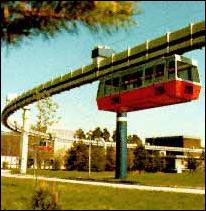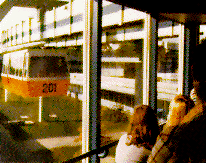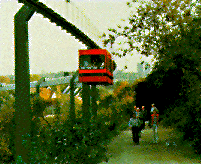SIPEM - Siemens People Mover System
 SIPEM is the latest version of a German technology
that was originally called H-Bahn, a suspended monorail transit system. The first system
started revenue passenger service in 1984 in Dortmund. This installation was preceded by a
test system at the Siemens Research Center at Erlangen in cooperation with DUWAG AG. The
system in Dortmund is the first automatically-controlled urban transit system in Germany.
By 1991, it had carried more than 5 million passengers without an accident. The initial
line was built at Dortmund University and linked two university campuses (see H-Bahn web site at Dortmund University)
SIPEM is the latest version of a German technology
that was originally called H-Bahn, a suspended monorail transit system. The first system
started revenue passenger service in 1984 in Dortmund. This installation was preceded by a
test system at the Siemens Research Center at Erlangen in cooperation with DUWAG AG. The
system in Dortmund is the first automatically-controlled urban transit system in Germany.
By 1991, it had carried more than 5 million passengers without an accident. The initial
line was built at Dortmund University and linked two university campuses (see H-Bahn web site at Dortmund University)
 It has since been extended beyond the confines of the university
into a residential area. Another extension provides a link to a rapid transit (S-Bahn)
station at the university. The new station at Eichlinghofen is at ground level so
passengers alighting from buses do not have to use stairs to reach the platform. A second
station has been situated directly over the S-Bahn tunnel so that an elevator can bring
passengers right to the S-Bahn platform. Most recently, SIPEM is being used to connect a
high speed rail station with the terminal at Duesseldorf International Airport. It is
called SkyTrain
and is now (2003) operational. Information about this application is
provided. Two photos of the early stages of construction are
available as is more information at the Duesseldorf International Airport website.
It has since been extended beyond the confines of the university
into a residential area. Another extension provides a link to a rapid transit (S-Bahn)
station at the university. The new station at Eichlinghofen is at ground level so
passengers alighting from buses do not have to use stairs to reach the platform. A second
station has been situated directly over the S-Bahn tunnel so that an elevator can bring
passengers right to the S-Bahn platform. Most recently, SIPEM is being used to connect a
high speed rail station with the terminal at Duesseldorf International Airport. It is
called SkyTrain
and is now (2003) operational. Information about this application is
provided. Two photos of the early stages of construction are
available as is more information at the Duesseldorf International Airport website.
 This suspended monorail technology is reported to
have a capacity of 15,000 passengers per hour per direction which puts it in an
intermediate category. The minimum headway (time interval between vehicles) is 6 seconds,
and its active switches can operate in less than 5 seconds. The maximum capacity of the
vehicle is 65 passengers and its maximum speed is 65 kph. Its steel guideway is
prefabricated off-site and can be erected quickly with minimum disruption to normal road
traffic. An illustration of this construction concept is
provided.
This suspended monorail technology is reported to
have a capacity of 15,000 passengers per hour per direction which puts it in an
intermediate category. The minimum headway (time interval between vehicles) is 6 seconds,
and its active switches can operate in less than 5 seconds. The maximum capacity of the
vehicle is 65 passengers and its maximum speed is 65 kph. Its steel guideway is
prefabricated off-site and can be erected quickly with minimum disruption to normal road
traffic. An illustration of this construction concept is
provided.
![[Dortmund University view]](sipem3.gif) The average distance between guideway columns is 25
m, the maximum is 35 m. According to the vendor, it is automatic and driverless, easy to
construct, independent of road traffic conditions, friendly to the environment,
comfortable, capable of all-weather operation, safe, reliable, economical and flexible. It
can be operated in a fixed cycle mode or in a demand-responsive mode that permits a
precise adaptation to normal changes in demand throughout the day.
The average distance between guideway columns is 25
m, the maximum is 35 m. According to the vendor, it is automatic and driverless, easy to
construct, independent of road traffic conditions, friendly to the environment,
comfortable, capable of all-weather operation, safe, reliable, economical and flexible. It
can be operated in a fixed cycle mode or in a demand-responsive mode that permits a
precise adaptation to normal changes in demand throughout the day.
 So far as is known, it has not been installed
anywhere other than Dortmund and the Dusseldorf International Airport. Project-specific
cost data are available from the vendor. Applications in residential areas, technology
parks, shopping centers, park/ride schemes, airports and as feeder/distributor connectors
to high capacity rail systems are thought to represent the best market niche for this
transit technology. Illustrations of these ideas are provided.
So far as is known, it has not been installed
anywhere other than Dortmund and the Dusseldorf International Airport. Project-specific
cost data are available from the vendor. Applications in residential areas, technology
parks, shopping centers, park/ride schemes, airports and as feeder/distributor connectors
to high capacity rail systems are thought to represent the best market niche for this
transit technology. Illustrations of these ideas are provided.
Information and graphics have been provided by: Siemens AG, Transportation Systems
Group, Turnkey Systems, Mass Transit, Werner-von-Siemens-Strasse 50, W-8520 Erlangen,
Germany. Tel: ++49-9131-727076; Fax: ++49-9131-726045.
Three sketches of SIPEM construction methods and vehicle
attributes
Four sketches of SIPEM application concepts
In 1998, the Siemens Company purchased MATRA, a French transit systems company. As a
result, it is reported that a decision has been made to drop SIPEM as a product and to go
forward only with the French VAL technology. Therefore, SIPEM should no longer be
considered to be a product offered by Siemens.

Last modified: October 08, 2010
 SIPEM is the latest version of a German technology
that was originally called H-Bahn, a suspended monorail transit system. The first system
started revenue passenger service in 1984 in Dortmund. This installation was preceded by a
test system at the Siemens Research Center at Erlangen in cooperation with DUWAG AG. The
system in Dortmund is the first automatically-controlled urban transit system in Germany.
By 1991, it had carried more than 5 million passengers without an accident. The initial
line was built at Dortmund University and linked two university campuses (see H-Bahn web site at Dortmund University)
SIPEM is the latest version of a German technology
that was originally called H-Bahn, a suspended monorail transit system. The first system
started revenue passenger service in 1984 in Dortmund. This installation was preceded by a
test system at the Siemens Research Center at Erlangen in cooperation with DUWAG AG. The
system in Dortmund is the first automatically-controlled urban transit system in Germany.
By 1991, it had carried more than 5 million passengers without an accident. The initial
line was built at Dortmund University and linked two university campuses (see H-Bahn web site at Dortmund University)  It has since been extended beyond the confines of the university
into a residential area. Another extension provides a link to a rapid transit (S-Bahn)
station at the university. The new station at Eichlinghofen is at ground level so
passengers alighting from buses do not have to use stairs to reach the platform. A second
station has been situated directly over the S-Bahn tunnel so that an elevator can bring
passengers right to the S-Bahn platform. Most recently, SIPEM is being used to connect a
high speed rail station with the terminal at Duesseldorf International Airport. It is
called SkyTrain
and is now (2003) operational. Information about this application is
provided. Two photos of the early stages of construction are
available as is more information at the Duesseldorf International Airport website.
It has since been extended beyond the confines of the university
into a residential area. Another extension provides a link to a rapid transit (S-Bahn)
station at the university. The new station at Eichlinghofen is at ground level so
passengers alighting from buses do not have to use stairs to reach the platform. A second
station has been situated directly over the S-Bahn tunnel so that an elevator can bring
passengers right to the S-Bahn platform. Most recently, SIPEM is being used to connect a
high speed rail station with the terminal at Duesseldorf International Airport. It is
called SkyTrain
and is now (2003) operational. Information about this application is
provided. Two photos of the early stages of construction are
available as is more information at the Duesseldorf International Airport website.  This suspended monorail technology is reported to
have a capacity of 15,000 passengers per hour per direction which puts it in an
intermediate category. The minimum headway (time interval between vehicles) is 6 seconds,
and its active switches can operate in less than 5 seconds. The maximum capacity of the
vehicle is 65 passengers and its maximum speed is 65 kph. Its steel guideway is
prefabricated off-site and can be erected quickly with minimum disruption to normal road
traffic. An illustration of this construction concept is
provided.
This suspended monorail technology is reported to
have a capacity of 15,000 passengers per hour per direction which puts it in an
intermediate category. The minimum headway (time interval between vehicles) is 6 seconds,
and its active switches can operate in less than 5 seconds. The maximum capacity of the
vehicle is 65 passengers and its maximum speed is 65 kph. Its steel guideway is
prefabricated off-site and can be erected quickly with minimum disruption to normal road
traffic. An illustration of this construction concept is
provided.![[Dortmund University view]](sipem3.gif) The average distance between guideway columns is 25
m, the maximum is 35 m. According to the vendor, it is automatic and driverless, easy to
construct, independent of road traffic conditions, friendly to the environment,
comfortable, capable of all-weather operation, safe, reliable, economical and flexible. It
can be operated in a fixed cycle mode or in a demand-responsive mode that permits a
precise adaptation to normal changes in demand throughout the day.
The average distance between guideway columns is 25
m, the maximum is 35 m. According to the vendor, it is automatic and driverless, easy to
construct, independent of road traffic conditions, friendly to the environment,
comfortable, capable of all-weather operation, safe, reliable, economical and flexible. It
can be operated in a fixed cycle mode or in a demand-responsive mode that permits a
precise adaptation to normal changes in demand throughout the day. So far as is known, it has not been installed
anywhere other than Dortmund and the Dusseldorf International Airport. Project-specific
cost data are available from the vendor. Applications in residential areas, technology
parks, shopping centers, park/ride schemes, airports and as feeder/distributor connectors
to high capacity rail systems are thought to represent the best market niche for this
transit technology. Illustrations of these ideas are provided.
So far as is known, it has not been installed
anywhere other than Dortmund and the Dusseldorf International Airport. Project-specific
cost data are available from the vendor. Applications in residential areas, technology
parks, shopping centers, park/ride schemes, airports and as feeder/distributor connectors
to high capacity rail systems are thought to represent the best market niche for this
transit technology. Illustrations of these ideas are provided.